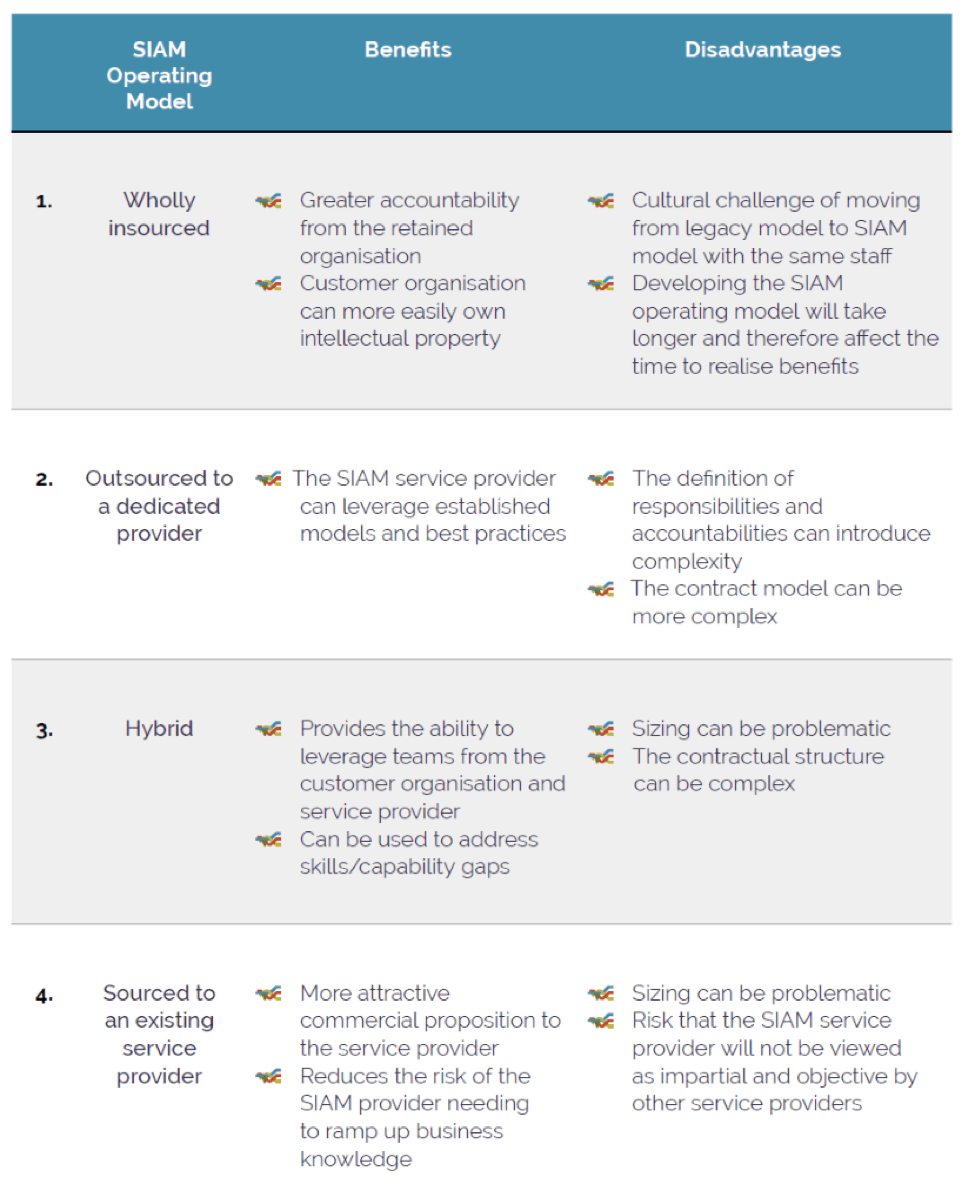Let’s talk about SIAM success. In my earlier service integration and management (SIAM) article I covered the whys and whats of SIAM. This blog looks at what SIAM involves in reality, starting with the required approach – for which there are a number of variations. And then offers ten key steps for SIAM success.
The Different SIAM Approaches

There are four common SIAM approaches that can be adopted, dependent upon the organization’s specific requirements.
Source: Epicon
Each of the models above has its own benefits and drawbacks in terms of SIAM success. The adoption of one model over another will be dependent upon the specific needs of the organization. The table below describes the benefits and disadvantages of each model at a high level.

Source: Epicon
10 Key Steps for SIAM Success
To prepare for, and to deliver, a successful transition to a SIAM operating model, i.e. SIAM success, organizations should seek to address the following ten points:
- Understand if SIAM is the right model for your organization. Following an initial SIAM baseline assessment, organizations will know if they should initiate a transformation program aimed at establishing, or improving, a SIAM capability.
- Develop a target operating model (TOM). Taking the sourcing strategy as a key input, it should describe the structure of the IT organization, which process model you will adopt, your approach to tooling in general and specifically to your IT service management (ITSM) tool, and the over-arching governance model for the SIAM ecosystem.
- Align the TOM to business strategy. This should involve understanding how key business stakeholders wish to engage with IT in terms of service governance (e.g. service performance reviews, measurement and reporting of service performance, and the development of KPIs aligned to business outcomes for the service), along with their strategic direction and goals.
- Define your tooling strategy. Don’t assume that your SIAM ecosystem’s service providers will own and maintain the required IT tools. There are benefits to the retained organization owning these tools, particularly the ITSM toolset, such that you can control your master data, workflows, and ticket data, from a single-source-of-truth. The tooling strategy should not only consider the ITSM tool used for incident, problem, change management, etc., but also the tools used across the enterprise to manage the IT services being delivered.
- Design the IT organization structure for SIAM success. Once the IT strategy and operating model are designed, there’s a need to develop a comprehensive IT organization structure. While these are being designed to meet the specific needs of the business, it’s advisable to leverage established a process and governance frameworks, such as ITIL, COBIT, and ISO20000 to ensure that the activities, and their division between the retained organization and the sourcing partners, are clear.
- Define the SIAM scope. It’s essential to clearly define the scope of the SIAM function, whether retained or sourced so that it’s clear where the accountability lies. The key considerations at a process level are the degree of authority it possesses and the level of interaction with sourcing partners and the business.
- Procure, configure, and test the required tools. A tooling strategy should form the basis for procurement decisions relating to the tool, or tools, that will underpin the SIAM program. The SIAM toolset often comprises several tools that together provide the required functionality. There are huge benefits to the retained organization owning elements of the SIAM toolset, particularly the ITSM tool, which acts as the focal point for so many of the process activities in a SIAM model.
- Encourage positive behaviors. KPIs can be a source of frustration in an outsourced environment, as each party may have a different way of defining and measuring “SIAM success”. Or an inconsistent measurement method is adopted across different service providers, either due to tooling, process, or organizational constraints. Recognize that the way service providers are measured heavily influences their ways of working and their behavior when dealing with each other, the SIAM provider (if applicable), and the retained IT organization.
- Undertake a skills gap analysis. When organizations are devising their SIAM-based operating model and organization design, they will probably discover skills gaps. This is typically due to the following factors: ITSM is largely undertaken by the service provider in the legacy sourcing contracts; retained staff are heavily biased towards supplier management as opposed to ITSM and ITIL or vice versa; a need for greater understanding of the activities required to achieve integration of the service providers’ services to business services; and no previous experience of the governance models required to manage a multi-service provider ecosystem.
- Build the SIAM capability first. Using the organizational design, TOM, and tooling strategy as the blueprint, the retained or sourced SIAM function should be established prior to the transition to the new sourcing model. This ensures that the SIAM function can influence the new service providers, establish ways of working and demonstrate value from the outset. It also enables organizations to tweak the SIAM design before all the service providers come on board.
So that’s ten key steps for SIAM success, you can find out more in this SIAM whitepaper. What would you add to my list? Please let me know in the comments.
If you liked this SIAM success article, here are some more SIAM articles:

